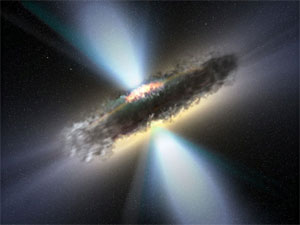This article is more than 1 year old
Hidden black holes elude astronomers
Living up to their name, then
It would seem, to the casual observer, a relatively simple thing to keep track of something with a mass millions of times that of our sun, but astronomers are having trouble locating supermassive black holes in neighbouring galaxies.
The researchers, from the US and Europe, suggest that either black holes are better hidden than scientists have thought, or they are only to be found on the outskirts of the universe.

Hidden supermassive black holes have been used to explain the universe's background X-ray radiation. The theory is that black holes are hiding behind huge clouds of dust capable of absorbing all but the highest energy X-ray radiation. Once these X-Rays make it out from behind the shrouds of dust, they combine to form the high energy peaks in the radiation that permeates the universe.
However, researchers working on a high energy census of our skies have not been able to find enough of the hidden black holes to account for all the observed radiation.
In January this year Italian astronomers used the European Space Agency's International Gamma Ray Astrophysics Laboratory, Integral, to show that the fraction of black holes in the nearby universe that are hidden behind these clouds of dust is around 15 percent.
Now a team of US and Swiss astronomers from NASA Goddard Space Flight Center in Greenbelt, Maryland, and the Integral Science Data Centre near Geneva, have analysed two years of continuous data from Integral and concluded that the proportion of hidden black holes could be as low as one in ten.
"Naturally, it is difficult to find something we know is hiding well and which has eluded detection so far," says Volker Beckmann of NASA Goddard. "Integral is a telescope that should see nearby hidden black holes, but we have come up short."
There are a few possible explanations. First, that if hidden black holes are responsible for the observed energy, that they are hidden further away. It could be that nearby supermassive black holes have had time to consume all the dust that would have shrouded them. Since the X-rays are produced by matter falling into the black holes, these naked black holes would not produce any.
Another possibility is that the black holes are just more hidden than astronomers realised, and are below the detection capabilities even of Integral.
NASA says more work is planned, and that the Swift satellite, in orbit to detect Gamma Ray Bursters, should be able to provide useful data. ®
